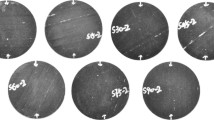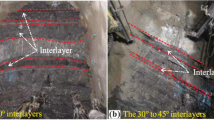Abstract
A validated particle flow code (PFC2D)-based model was developed to investigate the indirect tensile mechanical behavior of shale containing two central parallel cracks under Brazilian splitting test conditions. The results show that preexisting cracks have a significant and insignificant influence on the tensile strength of shale under LPL and LVL conditions, respectively. When L ⩾ 10 mm, changing the L and H values has little effect on the tensile strength of shale. However, the inclusion of preexisting cracks have a positive effect on reducing the anisotropy of the shale specimens, and in the case of an L/D ratio of 0.3, the shale anisotropy is the lowest. Four failure modes were formed at different β and θ values under LPL conditions. In the case of β⩾60°, the failure mode is mainly affected by β, and when β⩽45°, the failure mode is more complicated than in the case of β⩾ 60°. Only three major failure modes were observed under LVL conditions; in the case of 45°⩽β⩽75° and θ⩽30°, the most complex failure mode occurred.
Similar content being viewed by others
References
Cai M (2013). Fracture initiation and propagation in a Brazilian disc with a plane interface: a numerical study. Rock Mech Rock Eng, 46(2): 289–302
Cai M, Kaiser P K (2004). Numerical simulation of the Brazilian test and the tensile strength of anisotropic rocks and rocks with pre-existing cracks. Int J Rock Mech Min, 41(3): 450–451
Chen C S, Pan E, Amadei B (1998). Determination of deformability and tensile strength of anisotropic rock using Brazilian tests. Int J Rock Mech Min, 35(1): 43–61
Claesson J, Bohloli B (2002). Brazilian test: stress field and tensile strength of anisotropic rocks using an analytical solution. Int J Rock Mech Min, 39(8): 991–1004
Potyondy D O, Cundall P A (2004). A bonded-particle model for rock. Int J Rock Mech Min, 41(8): 1329–1364
Dong S M (2008). Theoretical analysis of the effects of relative crack length and loading angle on the experimental results for cracked Brazilian disk testing. Eng Fract Mech, 75(8): 2575–2581
Fowell R J, Xu C (1994). The use of the cracked Brazilian disc geometry for rock fracture investigations. Int J Rock Mech Min Sci Geomech Abstr, 31(6): 571–579
Fowell R J, Xu C, Dowd P A (2006). An update on the fracture toughness testing methods related to the cracked chevron-notched brazilian disk (CCNBD) specimen. Pure Appl Geophys, 163(5–6): 1047–1057
Ghazvinian A, Nejati H R, Sarfarazi V, Hadei M R (2013). Mixed mode crack propagation in low brittle rock-like materials. Arab J Geosci, 6(11): 4435–4444
Guo H, Aziz H I, Schmidt L C (1993). Rock fracture-toughness determination by the Brazilian test. Eng Geol, 33(3): 177–188
Haeri H, Khaloo A, Marji M F (2015). Experimental and numerical analysis of Brazilian discs with multiple parallel cracks. Arab J Geosci, 8: 5897–5908
Haeri H, Shahriar K, Fatehimarji M, Moarefvand P (2014a). On the crack propagation analysis of rock like Brazilian disc specimens containing cracks under compressive line loading. Lat AM J Solids Stru, 11(8): 1400–1416
Haeri H, Shahriar K, Marji M F, Moarefvand P (2014b). Experimental and numerical study of crack propagation and coalescence in precracked rock-like disks. Int J Rock Mech Min, 67: 20–28
ISRM (1978). Suggested methods for determining tensile strength of rock materials. Int J Rock Mech Min Sci Geomech Abstr, 15(3): 99–103
Li D Y, Wong Y E (2013). The Brazilian disc test for rock mechanics applications: review and new insights. Rock Mech Rock Eng, 46(2): 269–287
Li L C, Li S H, Tang C A (2014). Fracture spacing behavior in layered rocks subjected to different driving forces: a numerical study based on fracture infilling process. Front Earth Sci, 8(4): 472–489
Liu J, Xie L Z, He B, Gan Q, Zhao P (2021). Influence of anisotropic and heterogeneous permeability coupled with in-situ stress on CO2 sequestration with simultaneous enhanced gas recovery in shale: quantitative modeling and case study. Int J Greenh Gas Control, 104: 103208
Mellor M, Hawkes I (1971). Measurement of tensile strength by diametral compression of discs and annuli. Eng Geol, 5(3): 173–225
Park B, Min K B (2015). Bonded-particle discrete element modeling of mechanical behavior of transversely isotropic rock. Int J Rock Mech Min, 76: 243–255
Park B, Min K B, Thompson N, Horsrud P (2018). Three-dimensional bonded-particle discrete element modeling of mechanical behavior of transversely isotropic rock. Int J Rock Mech Min, 110: 120–132
Rocco C, Guinea G V, Planas J, Elices M (1999). Size effect and boundary conditions in the brazilian test: theoretical analysis. Mater Struct, 32: 437–444
Saksala T, Hokka M, Kuokkala V T, Mäkinen J (2013). Numerical modeling and experimentation of dynamic Brazilian disc test on Kuru granite. Int J Rock Mech Min, 59: 128–138
Sarfarazi V, Haeri H, Marji M F, Zhu Z M (2017). Fracture mechanism of Brazilian discs with multiple parallel notches using PFC2D. Period Polytech Civ Eng, 61(4): 653–663
Suo Y, Chen Z X, Rahman S (2018). Experimental and numerical investigation of fracture toughness of anisotropic shale rocks. In: Proceedings of the 6th Unconventional Resources Technology Conference (URTeC), Houston, TX, USA
Tan X, Konietzky H, Frühwirt T, Dan D Q (2015). Brazilian tests on transversely isotropic rocks: laboratory testing and numerical simulations. Rock Mech Rock Eng, 48(4): 1341–1351
Tavallali A, Vervoot A (2010). Effect of layer orientation on the failure of layered sandstone under Brazilian test conditions. Int J Rock Mech Min, 47(2): 313–322
Wang J, Xie L Z, Xie H P, Ren L, He B, Li C B, Yang Z P, Gao C (2016). Effect of layer orientation on acoustic emission characteristics of anisotropic shale in Brazilian tests. J Nat Gas Sci Eng, 36: 1120–1129
Wang Y, Li C H, Hu Y Z, Mao T Q (2017). Brazilian test for tensile failure of anisotropic shale under different strain rates at quasi-static loading. Energies, 10(9): 1324
Wang Z J, Jacobs F, Ziegler M (2014). Visualization of load transfer behaviour between geogrid and sand using PFC2D. Geotext Geomembr, 42(2): 83–90
Wu S C, Ma J, Cheng Y, Xu M F, Huang X Q (2018). Numerical analysis of the flattened Brazilian test: failure process, recommended geometric parameters and loading conditions. Eng Fract Mech, 204: 288–305
Xia L, Zeng Y W (2018). Parametric study of smooth joint parameters on the mechanical behavior of transversely isotropic rocks and research on calibration method. Comput Geotech, 98(JUN): 1–7
Yang B D, Jiao Y, Lei S T (2006). A study on the effects of microparameters on macroproperties for specimens created by bonded particles. Eng Comput, 23(6): 607–631
Yang S Q, Huang Y H (2014). Particle flow study on strength and mesomechanism of Brazilian splitting test for jointed rock mass. Acta Mech Sinica-prc, 30(4): 547–558
Yoon J (2007). Application of experimental design and optimization to PFC model calibration in uniaxial compression simulation. Int J Rock Mech Min, 44(6): 871–889
Yuan R F, Shen B T (2017). Numerical modelling of the contact condition of a Brazilian disk test and its influence on the tensile strength of rock. Int J Rock Mech Min, 93: 54–65
Zhang Y, Li T Y, Xie L Z, Yang Z P, Li R Y (2017). Shale lamina thickness study based on micro-scale image processing of thin sections. J Nat Gas Sci Eng, 46: 817–829
Zhao P, Xie L, Fan Z, Deng L, Liu J (2021). Mutual interference of layer plane and natural fracture in the failure behavior of shale and the mechanism investigation. Petrol Sci, 18(2): 618–640
Acknowledgements
We acknowledge the financial support from the Science and Technology Department of Sichuan Province (Nos. 2021YFH0048 and 2021YFH0118) and a project funded by the China Postdoctoral Science Foundation (No. 2020M683253).
Author information
Authors and Affiliations
Corresponding author
Rights and permissions
About this article
Cite this article
He, B., Liu, J., Zhao, P. et al. PFC2D-based investigation on the mechanical behavior of anisotropic shale under Brazilian splitting containing two parallel cracks. Front. Earth Sci. 15, 803–816 (2021). https://doi.org/10.1007/s11707-021-0895-8
Received:
Accepted:
Published:
Issue Date:
DOI: https://doi.org/10.1007/s11707-021-0895-8




